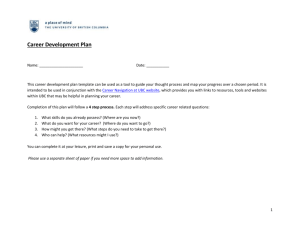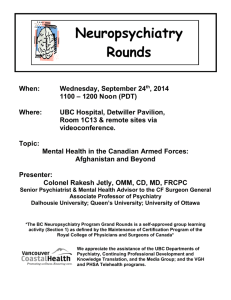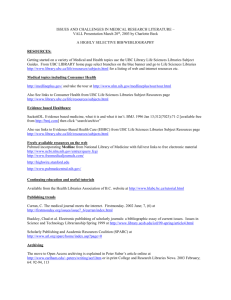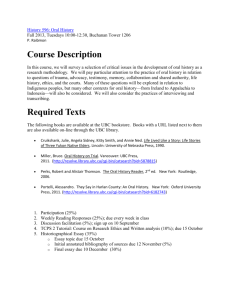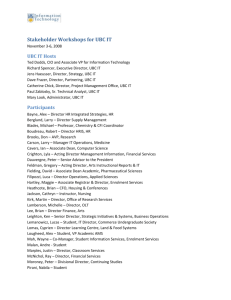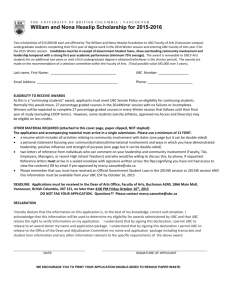How a Handful of Scientists Obscured the Truth on Issues from
advertisement
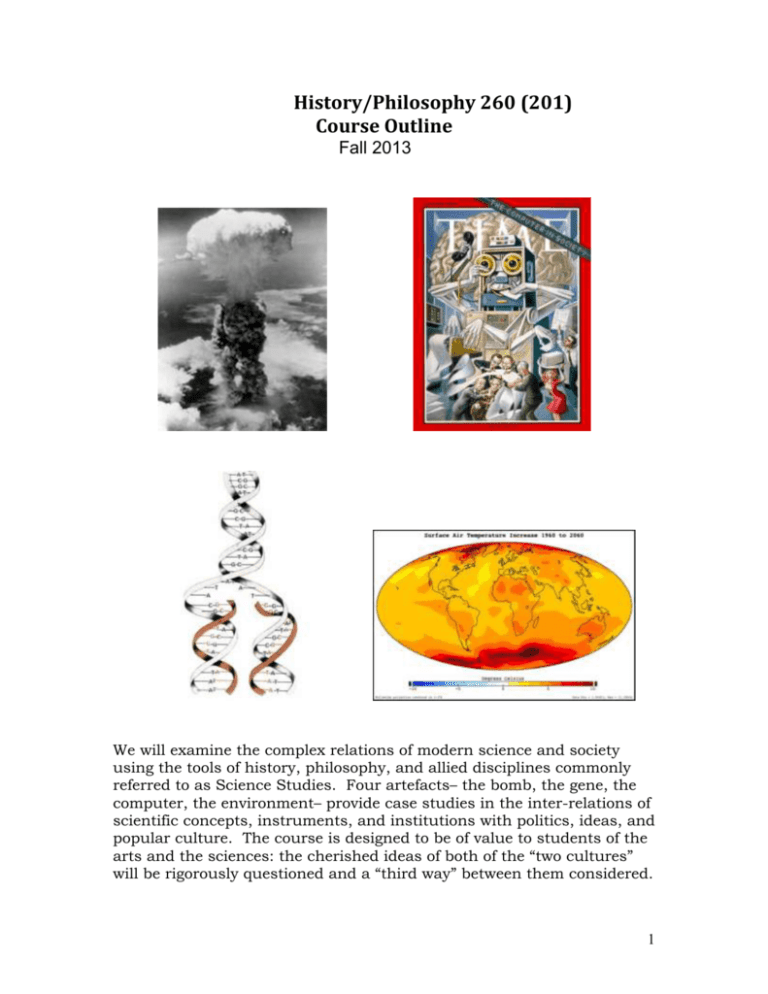
History/Philosophy 260 (201) Course Outline Fall 2013 We will examine the complex relations of modern science and society using the tools of history, philosophy, and allied disciplines commonly referred to as Science Studies. Four artefacts– the bomb, the gene, the computer, the environment– provide case studies in the inter-relations of scientific concepts, instruments, and institutions with politics, ideas, and popular culture. The course is designed to be of value to students of the arts and the sciences: the cherished ideas of both of the “two cultures” will be rigorously questioned and a “third way” between them considered. 1 Lecture Schedule September 5: Introduction September 10: The Physicist’s Century September 12: The Manhattan Project September 17: Film: “The Day After Trinity” September 19: The Hiroshima Decision September 24: Big Science September 26: Atomic Culture I October 1: Cold War Counterculture October 3: Nuclear Proliferation and Disarmament October 8: Eugenics and the Quest for Human Perfectibility: Introduction October 10: Eugenics and the Quest for Human Perfectibility: Great Britain and the United States October 15: Eugenics and the Quest for Human Perfectibility: Canada October 17: Film: “The Sterilization of Leilani Muir” October 22: Eugenics and the Quest for Human Perfectibility: Nazi Germany October 24: The Rise of Genetic Tests and Technologies October 29: The Age of Enhancement or Neo-Eugenics? October 31: Enlightened Automata and Difference Engines November 5: Cybernetics and WWII November 7: Alan Turing’s Enigmas November 12: Androids, Cyborgs and Post-Humans 2 November 14: History of the Internet November 19: History of Global Warming November 21: Merchants of Doubt November 26: On Bullshit (in general) November 28: Review and Reflection [Final Exam Review Sessions TBA] 3 Schedule of Readings & Discussion Week 1: (Bomb) The Physicists *Michael Frayn, Copenhagen (Toronto: Random House, 1998). (ON) Browse the American Institute of Physics website: “The Discovery of Fission,” Moments of Discovery http://www.aip.org/history/mod/fission/fission1/01.html No Tutorial Week 2: (Bomb) Manhattan Project **Thomas P. Hughes, “Tennessee Valley and Manhattan Engineer District,” American Genesis: A Century of Invention and Technological Enthusiasm, 1870-1970 (New York, London, Toronto: Penguin, 1989), 353-442. **Robert Oppenheimer, “Atomic Explosives,” The Open Mind (New York: Simon and Schustre, 1955). Tutorial: Discussion of Frayn, Copenhagen. Week 3: (Bomb) Bomb Decision/Big Science * J. Samuel Walker, Prompt and Utter Destruction: Truman and the Use of Atomic Bombs against Japan (Chapel Hill: University of North Carolina Press, 1997). 144 pp. (ON) President Harry S. Truman, “Statement by the President Announcing the Use of the A-Bomb at Hiroshima,” 6 Aug 1945. http://trumanlibrary.org/publicpapers/index.php?pid=100&st=&st1= (ON) Dwight D. Eisenhower, “Farewell to the Nation, 17 January 1961” www.fordham.edu/halsall/mod/1961eisenhower-farewell.html (ON) Alvin Weinberg, “Impact of Large-Scale Science on the United States,” Science, New Series, vol. 134, no. 3473 (Jul. 21, 1961), 161-164. Tutorial: Tours of TRIUMF @ UBC Week 4: (Bomb) Atomic Culture 4 (ON) CBC Digital Archives on “Cold War Culture: The Nuclear Fear of the 1950’s and 1960’s”. Watch several video clips and listen to several radio episodes of your choice. archives.cbc.ca/300c.asp?id=1-71-274 **Paul Boyer, “’The Whole World Gasped’”, By the Bomb’s Early Light: American Thought and Culture at the Dawn of the Atomic Age (Chapel Hill: Univ. of North Carolina Press, 1994), 3-26. Tutorial: Discuss Boyer, CBC archival material Week 5: (Bomb) Cold War Counterculture/ Nuclear Proliferation **“The World in Miniature,” The Journal of the New Alchemists, pp. 55-77 (ON) Dwight D. Eisenhower’s “Atoms for Peace” Address to the United Nations General Assembly, December 8, 1953. www.eisenhower.utexas.edu/atoms.htm **“China Breaks the European Cartel,” Thomas C. Reed and Danny B. Stillman, The Nuclear Express: A Political History of the Bomb and its Proliferation (Minneapolis: Zenith Press, 2009). Week 6: (Gene): From Soft to Hard Inheritance **Charles Darwin, The Descent of Man (selections) **Francis Galton, “Hereditary Talent and Character,” Macmillan's Magazine (1865) 12, 157-166, 318-327. **Francis Galton, “Eugenics: Its definition, scope, and aims,” in Galton, Essays in Eugenics (1909) Tutorial: Discussion of Darwin and Galton. Week 6: Gene **Henry H. Goddard, The Kallikak family; a study in the heredity of feeble-mindedness (1912). (ON) Frances Oswald, “Eugenical Sterilization in the United States,” American Journal of Sociology 36:1 (July 1930), 65-73. 5 Recommended: Cold Springs Harbor Eugenics Image Archive: http://www.eugenicsarchive.org/eugenics/ Tutorial: Discuss Goddard and early U.S. eugenics Week 7: Gene **Angus McLaren, Our Own Master Race: Eugenics in Canada, 1885-1945 (Toronto: McClelland & Stewart, 1990), (selections). *Robert Proctor, Nazi Racial Hygiene (chapters 3, 4, and 7). Week 8: Gene (ON) Michael J. Sandel, “The Case Against Perfection: What’s Wrong with designer children, bionic athletes, and genetic engineering,” The Atlantic Monthly (Apr 2004): 50-54,56-60,62. (ON) Garland Allen, “Is a New Eugenics Afoot?” Science 294. 5540 (2001), 59. Week 9: (Computer) The Mind in the Industrial Order *Jon Agar, Turing and the Universal Machine: The Making of the Modern Computer, 1-38. Tutorial: Discussion of Agar. Week 10: (Computer) Cybernetics: Mind, Brain, and Machine *Agar, Turing and the Universal Machine. . ., (ON) Peter Galison, 'The Ontology of the Enemy: Norbert Wiener and the Cybernetic Vision', Critical Inquiry 21:1 (1994), 228-266. (ON) Norbert Wiener, “Cybernetics,” Scientific American 179:5 (November 1948), 14-19. Tutorial: Discussion of Agar, Galison, and Wiener. Week 11: (Computer) Turing’s Problem and the Cybersociety (ON) Alan Turing “Computing Intelligence and Machinery” [1951] 6 (ON) John Searle, “Minds, Brains, and Programs” Behavioral and Brain Sciences 3 (1980), 417-424. *Phillip K. Dick, Do Androids Dream of Electric Sheep? [1968] (New York: Ballantine, 1996). (ON) JCR Licklider, “Man-Computer Symbiosis,” IRE Transactions on Human Factors in Electronics (1960) Online: http://groups.csail.mit.edu/medg/people/psz/Licklider.html *Agar, Turing and the Universal Machine. . . , 120-149. Recommended: (ON) CERN (European Laboratory for Particle Physics) Web Site on CERN and the history of the WWW. See especially the proposal documents (ON) Wikipedia, “History of the World Wide Web.” Explore some of the links and sources. Tutorial: Discussion of Turing & Searle; Dick, Do Android’s Dream. . .? Week 12: Environment (ON) Spencer Weart, "The Idea of Anthropogenic Global Climate Change in the 20th Century," Wiley Interdisciplinary Reviews: Climate Change 1 (2010): 67-81, doi:10.1002/WCC.6 *Naomi Oreskes & Erik Conway, Merchants of Doubt: How a Handful of Scientists Obscured the Truth on Issues from Tobacco Smoke to Global Warming (New York: Bloomsbury Press, 2010). (ON) Browse the American Institute of Physics website on The Discovery of Global Warming and follow the links of your choice. www.aip.org/history/climate/ * Harry Frankfurt, On Bullshit Tutorial: Discuss Oreskes and Conway; Frankfurt Week 13: Environment (ON) Oliver Morton (May 10, 2007). "Climate change: Is this what it takes to save the world?". Nature 447 (7141): 132–136 7 Course Coordinates When: Tuesday/Thursday 9:30-10:50am Where: Chem C124 Instructor Dr. Robert M. Brain 1101 Buchanan Tower tel: (604) 822-5409 rbrain@mail.ubc.ca Office Hours: Tues 2:15-4:15 pm, or by appointment Teaching Assistants: Eric Michael Johnson Lachlan Fleetwood Tutorials Every student should be enrolled in a Friday tutorial. Attendance and full participation in tutorials is mandatory. Course Requirements & Grading Scheme --Tutorial Attendance and Participation: 20% --3 one-page response applying historical or philosophical thinking: 5% each = 15% total --Essay element 1: 5% -- Essay element 2: 15% -- Complete Essay: 25% -- Final Exam: 20% Important Dates September 5—First Class September 17—Last day to withdraw without the “W” standing recorded November 28—Last Lecture/Term Paper due Final Exam TBA 8 Course Policies Marking: Written work manifesting a high degree of originality or insight combined with clear writing and persuasive argumentation will be a candidate for marks in the “A” range. Work considered for the “B” range will be characterized either by 1) a lesser degree of originality or insight, but distinguished by clear writing and persuasive argumentation; or 2) a high degree of originality or insight, but with flaws in writing clarity or in argumentation. Works in the “C” range will be marked by average to low originality and various flaws or weaknesses in writing and argument. Works in the “D” range will be severely flawed, or will show a lack of due diligence in preparing assignments. “F” grades are to be awarded to those who demonstrate absence, dishonesty, or sheer insentience. Late papers: by consensus, late papers will have 5% subtracted from the mark for each day of tardiness, unless special permission has been granted by one of the instructors. Papers delivered after the beginning of class on the due dates will be considered one day late. PAPERS SENT BY EMAIL ATTACHMENT WILL NOT BE ACCEPTED UNLESS SPECIAL PERMISSION HAS BEEN GRANTED IN ADVANCE. Plagiarism: university policies on plagiarism will be strictly enforced. Any borrowing of the work of others without proper citation will be grounds for failing the course and possible referral to university authorities for disciplinary action. This includes any and all borrowing from printed works or websites, INCLUDING CREATIVE CUTTING AND PASTING. If you are in doubt about what constitutes plagiarism, please consult with either of the instructors, or visit the following UBC website: http://www.library.ubc.ca/clc/airc.html Special Tour of TRIUMF Laboratories During the fourth week tutorials will consist of a tour of the TRIUMF Laboratories at UBC. Attendance is mandatory. Resources for History/Philosophy 260 Academic English Support Program: http//cstudies.ubc.ca/academicenglish-support-program/index.html Resources for Writing @ UBC Please consider taking advantage of several available resources for help with research and writing class papers. 9 The UBC Writing Centre, located at Ponderosa Annex C, Room 101D, 2021 West Mall (tel: 604-822 9564) has staff members with skill, patience, and experience to help with writing. The History Writing Centre [http://www.history.ubc.ca/writingcentre/index.htm] is a web-based resource specializing in the craft of historical research and writing. There a number of classic manuals of research and academic writing and style. My favorite is Kate Turabian, A Manual for Writers of Term Papers, Theses, and Dissertations, 6th ed. (Chicago: University of Chicago Press, 1996). For questions concerning proper citation: http://help.library.ubc.ca/researching/how-to-cite Course Readings Information Course readings are available in three ways. Readings marked * are from books on order for the course, listed below. Readings marked ** can be found in the History-Philosophy 260 Course Reader, available at the UBC Bookstore. Readings marked (ON) are available online, usually through the UBC Library website. Course Objectives To introduce students to some major themes, events, and debates in the history and philosophy of science during the past century. To introduce students to several of the key analytical and methodological tools used by historians and philosophers of science. These will include: o Analysis of argumentation. o Primary source analysis o Secondary sources analysis o Context o Image analysis (non-art) o Library skills o Digital databases and sources To teach students the essentials of historical and philosophical writing, with emphasis on one or the other discipline, including o Selection and articulation of a thesis/argument o Selection and use of evidence 10 Attention to the relationship between form and content (eg. outlining, weaving together themes/arguments and narrative) To introduce students to public history o Consideration of the differences between professional and public history o Communicating history to different audiences o Communicating history through a variety of media, including visual, digital, sound, and digital short-form o Course Connect Website We will be using the UBC Connect website for several functions. The main page will have the syllabus, announcements, postings of interesting resources and events (students can also post here). There will be links to separate blogs for each tutorial section. The tutorial blogs will be a place for required, but informal discussion of readings and key themes of the course. Most weeks, students will need to post on the blog. Their posts can include one or more of the following elements: a reaction to something in the readings, a question about the readings, or a response to another student’s post. The tutorial leader will initiate and participate in each week’s blog discussion. We will also use the blogs for some broader tasks of self-assessment. Writing Assignments This course is designated a UBC Writing Intensive Course, which provides an opportunity for students to develop critical thinking and expository skills in their written work. In this course the ratio of TA’s students is smaller, in order to provide more extensive feedback and attention to individual students. You are encouraged to seize this opportunity to improve your writing skills! These are the assignments: -- 3 one-page responses applying historical and/or philosophical thinking: analyzing and criticising arguments, analyzing primary sources, and historiography. Essay Element 1: Introduction (one-page) 11 Essay Element 2: Introduction + outline of the arguments and evidence, including one-page fully written (3 pages) [also known as “not quite an essay”. Complete Essay (6-8 pages) In tutorial students will be responsible for introducing the week’s readings at least once during the term, in groups of two. Scheduled Final Exam: consisting of three parts: 1) Identifications; 2) Analysis of Primary Source; 3) Synthetic General Essay Resources for Writing @ UBC Students will have ample feedback and support for writing in this course. But as a general principle students should be aware of these UBC writing resources: The UBC Writing Centre, located at Ponderosa Annex C, Room 101D, 2021 West Mall (tel: 604-822 9564) has staff members with skill, patience, and experience to help with writing. The History Writing Centre [http://www.history.ubc.ca/writingcentre/index.htm] is a web-based resource specializing in the craft of historical research and writing. There a number of classic manuals of research and academic writing and style. My favorite is Kate Turabian, A Manual for Writers of Term Papers, Theses, and Dissertations, 6th ed. (Chicago: University of Chicago Press, 1996). For questions concerning proper citation: http://help.library.ubc.ca/researching/how-to-cite Course Readings Information Course readings are available in three ways. Readings marked * are from books on order for the course, listed below. Readings marked ** will be found on the course Connect website. Readings marked (ON) are available online, usually through the UBC Library website. Books On Order at UBC Bookstore (course books will be shelved under both History 260 and Philosophy 260). 12 13


